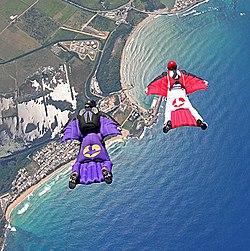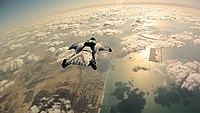Wingsuit BASE jumping
 Comment: Some of the text was copied from Wingsuit flying — Diannaa (talk) 15:30, 22 November 2020 (UTC)
Comment: Some of the text was copied from Wingsuit flying — Diannaa (talk) 15:30, 22 November 2020 (UTC)
Wingsuit BASE jumping or wingsuit BASE is the recreational sport of jumping from fixed objects wearing a wingsuit. BASE jumping is the recreational sport of jumping from fixed objects, using a parachute to descend safely to the ground. A wingsuit adds surface area to the human body to enable a significant increase in lift. Wingsuit BASE jumping is the combination of wingsuit flying and BASE jumping. Compared to normal BASE jumping, wingsuit BASE jumping allows pilots to fly far away from the cliffs they jumped from, and drastically increase their freefall time before deploying a parachute.
Wingsuit BASE is a sub-discipline of both BASE jumping and more general wingsuit flying. Wingsuit BASE jumpers must be advanced practitioners of both BASE jumping and flying a wingsuit in the skydiving environment. Unlike regular BASE jumping, wingsuit BASE enables jumpers to fly far away from the cliff they jumped off, substantially changing the risk profile. In contrast to wingsuit skydiving, wingsuit BASE jumpers must learn to exit from a cliff in still air, and have much less altitude to handle any potential problems.
Basics[edit]
Wingsuit BASE jumping involves 4 phases:
- Exit
- Flight
- Deployment
- Landing
History[edit]

An early attempt at wingsuit flying was made on 4 February 1912 by a 33 year-old tailor, Franz Reichelt, who jumped from the Eiffel Tower to test his invention of a combination of parachute and wing, which was similar to modern wingsuits. He misled the guards by saying that the experiment was going to be conducted with a dummy. He hesitated quite a long time before he jumped, and died when he hit the ground head first, opening a measurable hole in the frozen ground.[1]
Carl Boenish was the catalyst behind modern BASE jumping, and in 1978, he filmed the first BASE jumps which were made using ram-air parachutes and the freefall tracking technique (from El Capitan in Yosemite National Park).[2] While BASE jumps had been made prior to that time, the El Capitan jump was the effective birth of what is now called BASE jumping.
In 1999, Jari Kuosma of Finland and Robert Pečnik of Croatia teamed up to create a wingsuit that was safe and accessible to all skydivers. Kuosma established Bird-Man International Ltd. the same year. BirdMan's "Classic", designed by Pečnik, was the first wingsuit offered to the general skydiving public.
Technique[edit]

Wingsuit BASE jumping is an unregulated sport. But to perform the activity safely requires jumpers to be an experienced skydiver, wingsuit pilot, and BASE jumper. It takes hundreds of practice jumps to achieve skill in each of these disciplines before considering wingsuit BASE.
Launch[edit]
A wingsuit BASE jump begins by jumping from a cliff. Within seconds, air inflates the suit into a semi-rigid airfoil shape. The wingsuit flier enters free fall wearing both a wingsuit and parachute equipment. Exiting from a BASE jumping site, such as a cliff, or exiting from a helicopter, a paraglider, or a hot air balloon, is fundamentally different from exiting a moving aircraft, as the initial airspeed upon exit is absent. In these situations, a vertical drop using the forces of gravity to accelerate is required to generate the airspeed that wingsuits need to generate lift.

Glide[edit]
A wingsuit modifies the body area exposed to wind to increase the desired amount of lift with respect to drag generated by the body. With training, wingsuit pilots can achieve sustained glide ratio of 3:1 or more. This means that for every meter dropped, three meters are gained moving forward. With body shape manipulation and by choosing the design characteristics of the wingsuit, fliers can alter both their forward speed and fall rate. The pilot manipulates these flight characteristics by changing the shape of the torso, de-arching and rolling the shoulders and moving hips and knees, and by changing the angle of attack in which the wingsuit flies in the relative wind, and by the amount of tension applied to the fabric wings of the suit. The absence of a vertical stabilizing surface results in little damping around the yaw axis, so poor flying technique can result in a spin that requires active effort on the part of the skydiver to stop.
As suit technology and pilot skill have improved, wingsuit BASE jumpers have learned to control their flight so that they can fly just meters away from terrain. “Proximity flying” is the practice of flying a wingsuit close to the faces and ridges of mountains. Flying near terrain gives a greater sense of speed due to having a close visual reference. Loic Jean-Albert of France is one of the first proximity flyers, and his pioneering flying brought many BASE jumpers into the sport.[3] In November 2012, Alexander Polli became the first wingsuit BASE jumper to successfully strike a wingsuit target.[4]
Flare[edit]
Wingsuits can perform a landing flare in which airspeed is exchanged for additional lift. Modern wingsuits can flare enough to gain altitude, but only for a short period of time.
Deployment[edit]
At a planned altitude above, wingsuit BASE jumpers will deploy their parachute. Deployment is typically initiated by the pilot adjusting flight configuration to slow down their air speed, and then reaching back and throwing a pilot chute.[5] The parachute is flown to a controlled landing at the desired landing spot using typical parachute flight techniques.
Record-keeping[edit]
Wingsuit pilots often use tools including portable GPS receivers to record their flight path. This data can be analyzed later to evaluate flight performance in terms of fall rate, speed, and glide ratio. When jumping for the first time at a new location, BASE jumpers will often evaluate terrain using maps and laser range finders. By comparing a known terrain profile with previously recorded flight data, jumpers can objectively evaluate whether a particular jump is possible.[6] BASE jumpers also use landmarks, along with recorded video of their flight, to determine their performance relative to previous flights and the flights of other BASE jumpers at the same site.
Equipment[edit]

Modern wingsuits use a combination of materials in order to create an airfoil shape. The main surface is typically made from ripstop nylon, with various materials used to reinforce the leading edge, and reduce drag.[7]
Having a smooth leading edge is especially important as it is the source of most lift and most drag. Reducing inlet drag while maintaining high internal suit pressure is also important in modern wingsuit design.
Records[edit]
- Highest altitude
On 23 May 2006, the Australian couple Heather Swan and Glenn Singleman jumped from 6,604 metres (21,667 ft) off Meru Peak in India, setting a world record for highest wingsuit BASE jump.[8] This record was broken on 5 May 2013, by the Russian Valery Rozov, who jumped from 7,220 metres (23,690 ft) on Mount Everest's North Col.[9] Rozov broke his own record by jumping from 7,700 metres (25,300 ft) on Cho Oyu in 2016.[10]
- Longest horizontal distance
The longest verified wingsuit BASE jump is 7.5 kilometres (4.7 mi) by the American Dean Potter[11] on 2 November 2011. Potter jumped from the Eiger mountain and spent 3 minutes and 20 seconds in flight, descending 2,800 metres (9,200 ft) of altitude.
- Biggest
The biggest wingsuit BASE jump as measured from exit to landing was performed on 11 August 2013 by Patrick Kerber with a height of 3,240 metres (10,630 ft) off the Jungfrau in Switzerland.[12]
Further reading[edit]
- "The Great Book of BASE". BirdBrain Publishing. July, 2010.
References[edit]
- ↑ "Chute mortelle d'un inventeur de parachute". Le Temps (in French). Paris, FR. 6 February 1912. p. 4. Archived from the original on 25 February 2014. Retrieved 12 July 2013. Unknown parameter
|url-status=ignored (help)CS1 maint: Unrecognized language (link) - ↑ McCallum, Jack (August 26, 1985). "Who Needs An Airplane?". Sports Illustrated. 63 (9).
- ↑ "A Life in Flight: Wingsuit pioneer Loic Jean-Albert, "The Flying Dude"". Adventure Sports Journal. 2 April 2012.
- ↑ "Alexander Polli shatters a foam target while flying in a wingsuit". Outside Online. 26 November 2012.
- ↑ "Wingsuit Deployments". Squirrel. Retrieved 2020-09-12.
- ↑ "Pilot pioneers harrowing, low-level wingsuit flights". National Geographic. May 2015.
- ↑ "Squirrel Aura Wingsuit". Retrieved 11 May 2017.
- ↑ "Leap from the top of the world". Sydney Morning Herald. 8 June 2006. Retrieved 24 June 2012.
- ↑ Cooper, Tarquin (28 May 2013). "Valery Rozov BASE jumps from Mt. Everest". Red Bull.
- ↑ "Rozov BASE jumped Cho Oyu". ExplorersWeb. 25 Oct 2016. Retrieved 3 Jan 2020.
- ↑ "Dean Potters record breaking flight from the Eiger". Archived from the original on 22 April 2012.
- ↑ "Patrick Kerber sets an altitude distance record with a wingsuit BASE jump off the Jungfrau". Red Bull. Retrieved 2020-02-23.
This article "Wingsuit BASE jumping" is from Wikipedia. The list of its authors can be seen in its historical and/or the page Edithistory:Wingsuit BASE jumping. Articles copied from Draft Namespace on Wikipedia could be seen on the Draft Namespace of Wikipedia and not main one.

